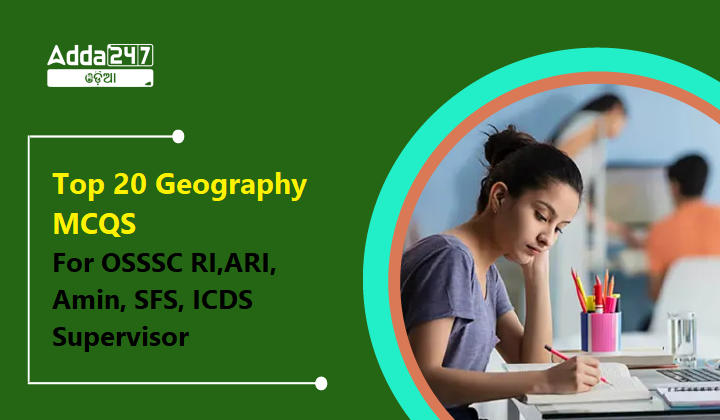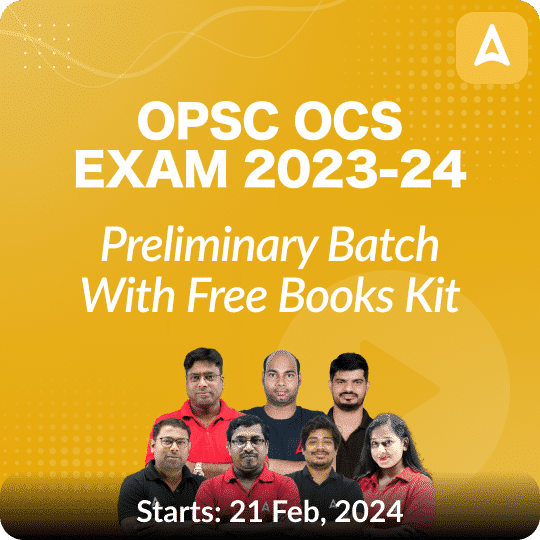Top 20 Geography MCQS For OSSSC RI,ARI, Amin, SFS, ICDS Supervisor
Preparing for competitive exams like the OSSSC RI, ARI, Amin, SFS, and ICDS Supervisor requires a solid grasp of general studies. Here are the top 20 multiple-choice questions (MCQs) along with their answers:
Q1. Mount Abu is a hill station situated in _____ ranges.
(a) Satpuda
(b) Vindhya
(c) Aravalli
(d) Sahyadri
S1.Ans. (c)
Sol. Mount Abu is a popular hill station in the Aravalli Range in Sirohi district of Rajasthan near the border with Gujarat.
Q2.Which of the following is called the Land of the Golden Pagoda’?
(a) Myanmar
(b) China
(c) Japan
(d) North Korea
S2.Ans.(a)
Sol. Myanmar is the country also known as the land of the Golden Pagoda. “Pagoda is partway Buddhist temple in which the mummies of followers and personalities are kept. Pagoda’s top is usually covered with golden sheet. Due to excess use of gold in pagoda’s this country is also known as the County of Golden Pagodas”.
Q3. Which of the following river of India is called Vridha Ganga –
(a) Godavari
(b) Krishna
(c) Kaveri
(d) Narmada
S3.Ans.(a)
Sol. The Godavari (Vridha Ganga or Dakshina Ganga) is the largest river system of the peninsular India & rises near Nasik in Maharashtra. Godavari is considered the Dhakshin (Southern) Ganga &Draksharama Dhakshin Kasi.
Q4. Which of the following statements is/are correct?
- Inter-Tropical Convergence Zone is a low pressure belt which forms an important zone of contact over Northern India and Pakistan.
- Inter-Tropical Convergence Zone invites inflow of winds from different directions. Select the correct answer using the code given below:
(a) 1 only
(b) 2 only
(c) Both 1 and 2
(d) Neither 1 nor 2
S4.Ans.(b)
Sol. The Inter tropical Convergence Zone (ITCZ), known by sailors as the doldrums, is the area encircling the earth near the equator where the northeast and southeast trade winds converge.
Q5.The transitional zone between two distinct communities is known as
(a) Ecotype
(b) Ecade
(c) Ecosphere
(d) Ecotone
S5.Ans.(d)
Sol. The transitional zone between two different communities is known as ecotone. It has some of the characteristics of each bordering biological community and often contains species not found in the overlapping communities.
Q6. The Great Himalayan National Park is in which state?
(a) Jammu & Kashmir
(b) Arunachal Pradesh
(c) Himachal Pradesh
(d) Sikkim
S6. Ans.(c)
Sol. The Great Himalayan National Park (GHNP), is one of India’s national parks, is located in Kullu region in the state of Himachal Pradesh.
Q7. Indian Standard Time is ahead of Greenwich Mean Time by-
(a) 5.30 hours
(b) 4:30 hours
(c) 4 hours
(d) 5 hours
S7.Ans.(a)
Sol. Indian Standard Time is 5 hours and 30 minutes ahead of Greenwich Mean Time.
Q8. On which river is the Tehri dam built?
(a) Alakananda
(b) Bhagirathi
(c) Ganga
(d) Hooghly
S8. Ans.(b)
Sol. The Tehri Dam is one of the highest dam in India. It is a multi-purpose rock and earth-fill embankment dam on the Bhagirathi River near Tehri in Uttarakhand, India.
Q9. With which country, India has the longest international boundary?
(a) Nepal
(b) Pakistan
(c) China
(d) Bangladesh
S9. Ans.(d)
Sol. India has the longest international boundary of 4,096 Km with Bangladesh.
Q10. In geography ‘Gulf Stream’ refers to
(a) A warm ocean current
(b) Strong air current
(c) Streams joining a gulf
(d) The name of a stream
S10. Ans.(a)
Sol. The Gulf Stream is a warm and swift Atlantic Ocean current that originates in the Gulf of Mexico and stretches to the tip of Florida, and follows the eastern coastlines of the United States and Newfoundland before crossing the Atlantic Ocean.
Q11. Which State in India has the largest coastline?
(a) Tamil Nadu
(b) Andhra Pradesh
(c) Gujarat
(d) West Bengal
S11. Ans.(c)
Sol. Gujarat has the longest coastline of 1214.7 km among all the states.
Q12. Jog falls in Karnataka is located over which river?
(a) Kaveri
(b) Godavari
(c) Sharavati
(d) Krishna
S12. Ans.(c)
Sol. Jog falls in Karnataka is located over Sharavati river. Jog Falls is situated on the borders of Shimoga and North Kannada district.
Q13. Which one of the following areas of India is covered by tropical evergreen forest?
(a) Semi-arid areas of Gujarat
(b) Eastern Ghats
(c) Western Ghats
(d) Central India
S13. Ans.(c)
Sol. In India, evergreen forests are found on the eastern and western slopes of the Western Ghats in such states as Tamil Nadu, Karnataka, Kerala and Maharashtra. And also found in Assam, Arunachal Pradesh, Meghalaya, Nagaland, Tripura, West Bengal and Andaman and Nicobar Islands.
Q14. Which of the following is not an Igneous Rock?
(a) Dolomite
(b) Granite
(c) Basalt
(d) Gabbro
S14. Ans.(a)
Sol. Dolomite is a common rock-forming mineral. It is a calcium magnesium carbonate with a chemical composition of CaMg(CO3)2. It is the primary component of the sedimentary rock known as dolostone and the metamorphic rock known as dolomitic marble.
Q15. On which date is India likely to experience the shortest day?
(a) December 21
(b) March 21
(c) June 22
(d) September 23
S15.Ans.(a)
Sol. Dec. 21 is the winter solstice: the shortest day and longest night of the year here in Earth’s northern hemisphere.
Q16. Which of the nations are connected with Palk Strait?
(a) India and Sri Lanka
(b) North Korea and South Korea
(c) Pakistan and China
(d) Britain and France
S16.Ans.(a)
Sol. The Palk Strait is a strait between the Tamil Nadu state of India and the Mannar district of the Northern Province of the island nation of Sri Lanka.
Q17. Intensive cultivation refers to –
(a) Production with intensive use of labour
(b) Production with intensive use of fertilizer
(c) Raising production by intensive use of existing land
(d) Raising production by large scale use of imported inputs
S17. Ans.(c)
Sol. Intensive farming (also intensive agriculture) is the practice where a lot of labor and capital is employed to maximize agricultural produce or yields. It is distinguished from traditional agriculture by a high ratio of inputs to land area.
Q18. Why does the west coast of India receive more rainfall from southwest monsoon than the east coast?
(a) Unlike the east coast this coast is straight
(b) The Western Ghats obstruct the winds causing rainfall
(c) The east coast is broader than the west coast
(d) The Eastern Ghats extend parallel to wind direction
S18. Ans.(b)
Sol. The west coast of India receive more rainfall from southwest monsoon than the east coast because the Western Ghats obstruct the winds.
Q19. River Indus originates at:
(a) Hindukush range
(b) Himalayan range
(c) Karakoram range
(d) Kailash range
S19. Ans.(d)
Sol. Indus River originates in Tibet in northern slopes of Mount Kailash near lake Mansarovar. Running via Ladakh, it enters into Pakistan through Gilgit-Baltistan and ends in Arabian Sea near Karachi.
Q20. Kaziranga National Park is a national park in the Golaghat and Nagaon districts of the state of?
(a) Assam
(b) West Bengal
(c) Uttar Pradesh
(d) Odisha
S20. Ans.(a)
Sol. Kaziranga National Park – a world heritage site, the park hosts two-thirds of the world’s Great One-horned rhinoceros. Kaziranga also boasts the highest density of tigers among the protected areas in the world and was declared a Tiger Reserve in 2006.
















